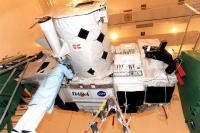ORFEUS-SPAS I
From The Space Library
 | |
| Organization | NASA-Office of Space Science Applications (United States),German Space Agency (Federal Republic of Germany) |
|---|---|
| Mission type | Astronomy |
| Launch date | September 12, 1993 |
| Launch vehicle | STS-51 |
| Carrier rocket | Space Shuttle |
| Launch site | Cape Canaveral, United States |
| COSPAR ID | 1993-058C |
| Mass | 3500.0 kg |
| Experiments | Here |
| Alternate Names | ORFEUS, SPAS, STS 51/ORFEUS, STS 51/SPAS, 22798 |
| Additional Information | Here |
| PDMP Information | Here |
| Telecommunications Information | Here |
| Data Collection | Here |
The purpose of the ORFEUS-SPAS I mission was to conduct investigations of celestial sources in the far and extreme ultraviolet spectral range. Specific objects targeted included the atmospheres of hot stars and the coronae of cool stars. Narrow interstellar absorption lines were studied to further understanding of the interstellar medium (ISM). ORFEUS-SPAS I was the first of a series of planned joint DARA (German Space Agency) /NASA missions. The name arises from the reusable Astro-Shuttle Pallet Satellite (Astro-SPAS), and the Orbiting Retrievable Far and Extreme Ultraviolet Spectrometers (ORFEUS) Telescope carried on Astro-SPAS. ORFEUS-SPAS was a free-flying platform designed to be deployed and retrieved from the space shuttle. The Astro-SPAS carrier was powered by batteries, and data from the instruments were stored on tape. Absolute pointing was accurate to within a few arc seconds. ORFEUS-SPAS is 4.5m length and has a 2.5m width base. Operation of ORFEUS-SPAS was approximately 40km from the shuttle. ORFEUS-SPAS carried three spectrometers operating over the wavelength range 400 - 1250 Angstroms. The Tubingen Ultraviolet Echelle Spectrometer (TUES) and the Berkeley Extreme and Far-UV Spectrometer (BEFS) were housed on the primary instrument - the ORFEUS 1-m telescope. The Interstellar Medium Absorption Profile Spectrograph (IMAPS) was operated independently from ORFEUS. The ORFEUS-SPAS I mission was flown in September 1993.
